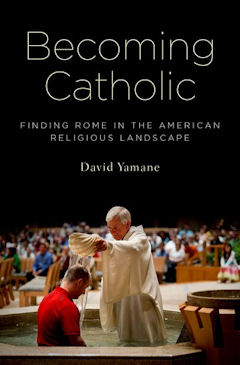
|
Posted October 24, 2014
Book: Becoming Catholic: Finding Rome in the American Religious Landscape [An Excellent resource for those involved with the RCIA] Author: David Yamane Oxford University Press. New York. 2014. Pp. 237 An Excerpt from the Jacket:
Conversion has been an essential element of Christianity, and especially of Roman Catholicism, for centuries --- from the Apostle Paul's dramatic conversion on the road to Damascus to the spiritual transformations of such prominent modern individuals as Cardinal Newman, St. Elizabeth Ann Seton, Thomas Merton, and G.K. Chesterton. In a 1926 essay, Chesterton expressed reluctance to describe his conversion, on account of "a strong feeling that this method makes the business look much smaller than it really is." As David Yamane shows in Becoming Catholic, the business was not only spiritually but literally very large, and growing ever larger: roughly 150,000 Americans join the Catholic Church each year, and more than one in fifty American adults is a Catholic convert. Altogether, these 5.85 million individuals are the firth-largest religious group in America. In this first significant study of the phenomenon of Roman Catholic conversion in the contemporary United States, Yamane provides an in-depth look at the process of adult initiation in the twenty-first century Catholic Church, including the new process of spiritual formation --- called the Rite of Christian Initiation of Adults (RCIA) --- that was ushered in by Vatican II. The RCIA process, which has become an integral part of Catholic parish life, takes individuals on a journey through four distinct, formative periods, punctuated by elaborate ritual transitions, before they are finally baptized at Easter. Drawing on years of observational fieldwork and candid interviews with more than 200 individuals undergoing the initiation process, Yamane follows would-be Catholics through all four stages of the RCIA and offers an incisive new perspective on what it means to choose Catholicism in America today. An Excerpt from the Book: The journey of initiation begins with the individual's decision to consider becoming Catholic and enter into the inquiry period. After many stops along the way, it ends with the period of post-baptismal catechesis known as mystagogy. Some involved in initiation ministry worry that for many new Catholics, mystagogy is not just the end of the RCIA process but the end of their active involvement in the church --- or at least the beginning of the end. If receiving the sacraments of initiation at the Easter Vigil is the climax of the process, then mystagogy is the anti-climax and sets the stage for the anti-climax nature of simply being a member of the Catholic Church on a day-to-day basis. Receiving the sacraments of initiation, like a school graduation, is important, but what follows is arguably even more important. A friend who has worked in initiation ministry for a number of years and worries about what becomes of individuals once they leave the friendly confines of the RCIA process once recalled the bittersweet song by Bruce Springsteen, "Glory Days." "There is nothing worse," she said, "than seeing these new Catholics who every time you see them after the RCIA is over, all they can talk about are the "glory days" of the RCIA. How great things were in the RCIA, how everyone cared about them, and they had a personal team of instructors and coaches and sponsors to look out for them. But that's not the reality of Church." What happens to these individuals one, five, or ten years down the road? Does their journey end? Do they settle into a routine of life in the church? Do they continue to grow in faith and involvement? No one really knows. I heighted ways in which individuals who become Catholic really change over the course of the RCIA process, and how the RCIA process itself makes a difference. But my second wave of data collection came immediately following the individual's initiation. More scholarship is needed in this area, to determine the levels of long-term incorporation and whether the RCIA process influences it. In the end, these reflections remind us that there are two meanings of the word initiation. Throughout this book I have treated initiation as a process that culminates in the individual's incorporation in the Catholic church. In this sense, initiation is the end of the RCIA process --- its goal, its climax, its conclusion. But initiation also has another meaning --- "to begin." At the same time that initiations ends, it also begins. As Mark Searle writes, upon receiving the sacraments of initiation, "The journey of initiation is complete. Yet, for Christian pilgrims, baptism is the first stage in a longer journey." Table of Contents: 1. Vatican II and the reinvention of Adult Initiation Diane Gall: Finding a home in Catholicism 2. The circumstantial convert as moral actor St. Mary's and St. Mark's: a tale of two parishes 3. Visions of Catholicism's in RCIA catechesis The rite of election: through the cathedral to purification and enlightenment 4. Liturgy, experience and formation St. Innocent: "A People Destined for Heaven Is Born Here from Holy Seed 5. Objective and subjective incorporation through the sacraments of initiation. Mystagogy: the end and the beginning 6. The difference it makes |
|
